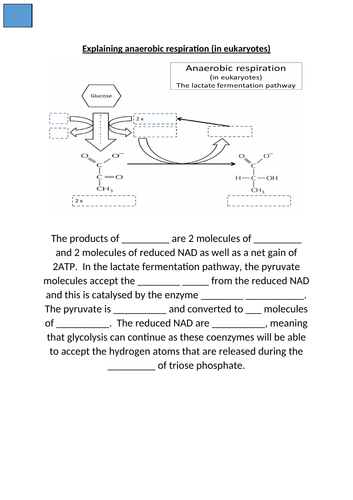




This fully-resourced lesson describes the process of anaerobic respiration in eukaryotes and explains how pyruvate can be converted to lactate or ethanol using the hydrogen atoms released from reduced NAD and that the reoxidation of this coenzyme allows glycolysis to continue. The engaging and detailed PowerPoint and accompanying differentiated resources have been designed to cover the first part of point 5.2.2 (i) of the OCR A-level Biology A specification which states that students should be able to demonstrate and apply their knowledge and understanding of anaerobic respiration in mammals and yeast.
The lesson begins with a focus on the coenzyme, NAD, and students are challenged to recall details of its role in the oxidation of triose phosphate. Students will recall that oxidative phosphorylation in aerobic respiration allows these coenzymes to be reoxidised and therefore recognise that another metabolic pathway has to operate when there is no oxygen available. Time is taken to go through the details of the lactate and ethanol fermentation pathways and students are encouraged to discuss the conversions before applying their knowledge to complete diagrams and passages about the pathways. Understanding checks in a range of forms are used to enable the students to assess their progress whilst prior knowledge checks allow them to recognise the links to earlier topics.
This lesson has been written to tie in with the other uploaded lessons on glycolysis and the stages of aerobic respiration
Get this resource as part of a bundle and save up to 33%
A bundle is a package of resources grouped together to teach a particular topic, or a series of lessons, in one place.
Module 5.2: Photosynthesis & Respiration (OCR A-level Biology A)
Photosynthesis and respiration are two of the most commonly-assessed topics in the terminal A-level exams but are often poorly understood by students. These 14 lessons have been intricately planned to contain a wide range of activities that will engage and motivate the students whilst covering the key detail to try to deepen their understanding and includes exam-style questions so they are prepared for these assessments. The following specification points in modules 5.2.1 and 5.2.2 of the OCR A-level Biology A course are covered by these lessons: * The structure of a chloroplast and the sites of the two main stages of photosynthesis * The light-dependent stage of photosynthesis * The fixation of carbon dioxide and the light-independent stage of photosynthesis * The uses of triose phosphate * Factors affecting photosynthesis * The need for cellular respiration * The structure of the mitochondrion * The process and site of glycolysis * The link reaction and its site in the cell * The process and site of the Krebs cycle * The importance of coenzymes in cellular respiration * The process and site of oxidative phosphorylation * The chemiosmostic theory * The process of anaerobic respiration in eukaryotes * The relative energy values of carbohydrates, lipids and proteins as respiratory substrates * The use of the respiratory quotient Due to the detail of these lessons, it is estimated that it will take in excess of 2 months of A-level lessons to cover this module If you would like to sample the quality of the lessons, download the uses of triose phosphate, link reaction and respiratory substrates lessons as these have been shared for free
Module 5.2.2: Respiration (OCR A-level Biology A)
All 9 of the lessons included in this bundle are fully resourced and have been designed to cover the detailed content of module 5.2.2 (Respiration) of the OCR A-Level Biology A specification. The following specification points are covered by this bundle of lessons: * The need for cellular respiration * The structure of the mitochondrion * The process and site of glycolysis * The link reaction and its site in the cell * The process and site of the Krebs cycle * The importance of coenzymes in cellular respiration * The process and site of oxidative phosphorylation * The chemiosmotic theory * The process of anaerobic respiration in eukaryotes * The difference in the relative energy values of carbohydrates, lipids and proteins * The use and interpretation of the respiratory quotient All of the lessons are detailed and engaging and contain regular progress checks so that students can assess their understanding of the current topic as well as prior knowledge checks to enable links between topics and modules to be seen It is estimated that these lessons will cover in excess of a month's A-level Biology teaching time
Something went wrong, please try again later.
Outstanding, creative, accurate and inspiring. Thank you.
I'm using this for AQA as the principle is the same. I'd got resources for the rest of respiration otherwise the bundle would have been more economical as £4 is a little steep. However, I think it test students and I like your worksheets and the fact there is differentiation especially as I have a range from A* to E as predicted grades
Report this resourceto let us know if it violates our terms and conditions.
Our customer service team will review your report and will be in touch.